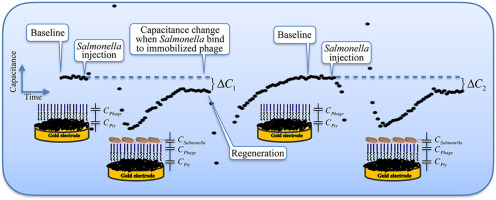Talanta ( IF 5.6 ) Pub Date : 2018-06-15 , DOI: 10.1016/j.talanta.2018.06.033
Saroh Niyomdecha , Warakorn Limbut , Apon Numnuam , Proespichaya Kanatharana , Ratthaphol Charlermroj , Nitsara Karoonuthaisiri , Panote Thavarungkul

|
This article reports the detection of Salmonella spp. based on M13 bacteriophage in a capacitive flow injection system. Salmonella-specific M13 bacteriophage was immobilized on a polytyramine/gold surface using glutaraldehyde as a crosslinker. The M13 bacteriophage modified electrode can specifically bind to Salmonella spp. via the amino acid groups on the filamentous phage. An alkaline solution was used to break the binding between the sensing surface and the analyte to allow renewable use up to 40 times. This capacitive system provided good reproducibility with a relative standard deviation (RSD) of 1.1%. A 75 µL min-1 flow rate and a 300 µL sample volume provided a wide linear range, from 2.0 × 102 to 1.0 × 107 cfu mL-1, with a detection limit of 200 cfu mL-1. Bacteria concentration can be analyzed within 40 min after the sample injection. When applied to test real samples (raw chicken meat) it provided good recoveries (100–111%). An enrichment process was also explored to increase the bacteria concentration, enabling a quantitative detection of Salmonella spp. This biosensor opens a new opportunity for the detection of pathogenic bacteria using bacteriophage.
中文翻译:

基于噬菌体的电容传感器用于沙门氏菌检测
本文报告了沙门氏菌属的检测。电容式流动注射系统中基于M13噬菌体的细菌。使用戊二醛作为交联剂,将沙门氏菌特异性M13噬菌体固定在聚酪胺/金表面。M13噬菌体修饰的电极可以特异性结合沙门氏菌。通过丝状噬菌体上的氨基酸基团。使用碱性溶液破坏传感表面和分析物之间的结合,可再生使用多达40次。该电容系统提供了良好的可重复性,相对标准偏差(RSD)为1.1%。75 µL min -1流速和300 µL样品体积提供了宽范围的线性范围,从2.0×10 2至1.0×10 7 cfu mL -1,检测限为200 cfu mL -1。进样后40分钟内可以分析细菌浓度。当用于测试真实样品(生鸡肉)时,可提供良好的回收率(100–111%)。还探索了富集过程以增加细菌浓度,从而能够定量检测沙门氏菌属。这种生物传感器为利用噬菌体检测病原细菌提供了新的机会。































 京公网安备 11010802027423号
京公网安备 11010802027423号